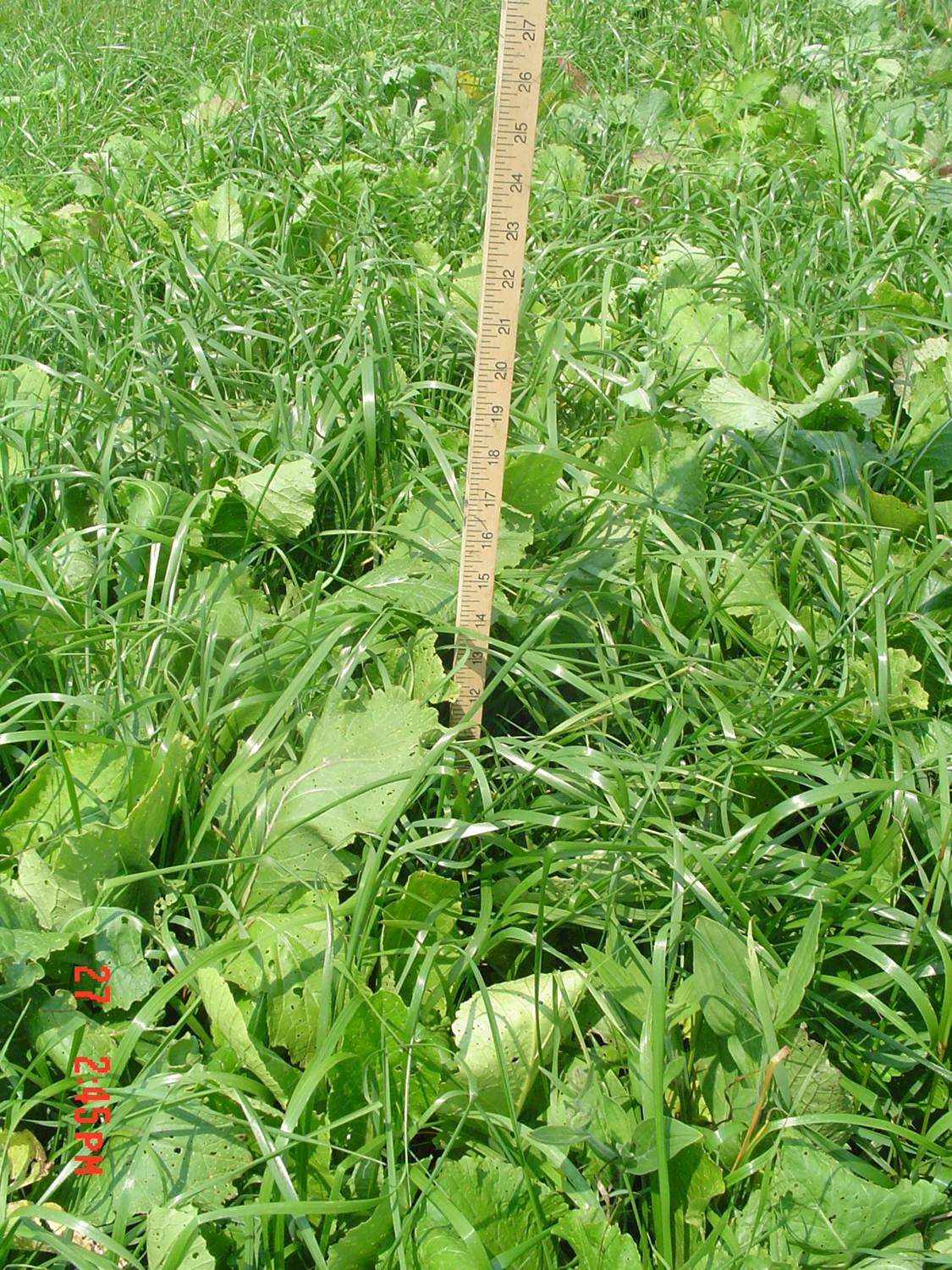Cover Crops for Grazing
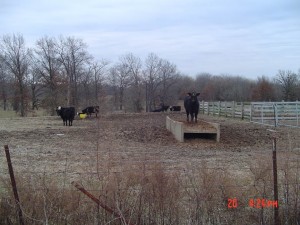
Drought ’12 is causing many cattle producers to consider cover crops for fall and winter grazing. Hay is very expensive and in short supply, and corn silage will be short in many areas. A lack of feed is leaving a number of dairy and beef producers looking to liquidate their herds.
Two years ago I wrote about grazing cover crops in the winter. It highlights the value of oats, cereal rye, and turnips in combination. There is also an attached video included with that article.
See this post for video from this past winter.
Several producers have seen beef cattle gain up to 3.5#/head/ day when grazing cover crops over the winter.
Gene Schriefer an Ag/Ag Business agent from Iowa County Wisconsin has seen great results with grazing cover crops. Gene reports:
I just completed my third season of grazing seed salad cover crops on my own farm and have been working with several of our local dairy and beef graziers about incorporating this into their rotation. Thus far the lowest RFQ has been 220. I’ve done summer mixed, cool season mixes and summer and cool season mixes together. While initial livestock experience has been skeptical, once they get a taste, cattle (and sheep) cannot get enough and refuse to eat orchardgrass/red clover.
Utilization with break wires appears to be 90% or more (I’ll need to do a pre/post grazing residual measure). In 2009, the first year I stockpiled an August seeding into December waiting for snowfall. An 11″ snow storm hit us early in December and I released the cattle. They bury their heads under a foot of snow digging out the crop. So far we’re pretty bullish on covers for grazing and looking at doing more. Uniformly everyone (myself included) find the ground to be very mellow the following spring for seeding…
I’ve been encouraging dairies to try cover crops for summer and early fall to aid in managing manure applications.
Here are some additional options that may work in different situations and for different animals too.
Fall Forage Fast – For Grazing
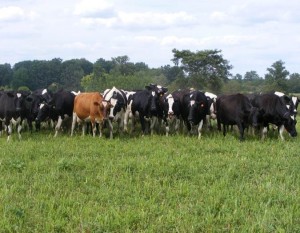
BMR Sudangrass or BMR Sorghum Sudangrass
In many areas it is getting late to plant these species (as of July 25). However, with good fertility, good moisture, and warm temperatures I have seen yields as high as seven tons of Dry Matter of BMR Sudangrass in the Thumb of Michigan when planted after wheat.
However, that included high fertility and excellent growing conditions. If it remains dry you should not plant these because you will run out of time to get adequate production. There are better options for shorter growing periods.
Oats and Appin Turnips
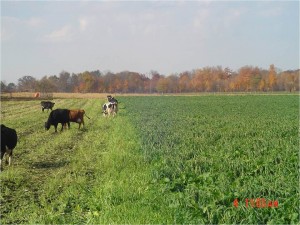
If a producer does not want to have their cover crop overwinter then Oats and Turnips are a great choice for fall and winter grazing. Plant 2 bu/acre of oats and add 5#/acre of Appin Turnips.
As you can see in the photo it is best to strip graze this mix to get the best results and the most feed. This mixture needs nitrogen and I’d recommend that you apply 50#/acre of actual N at planting time. This can be planted after wheat or after corn silage harvest in most regions.
Cereal Rye + Oats + Appin Turnips
This mix is for the producer that wants fall and spring feed. I have worked with this mixture since the early 2000’s with Ed Ballard (U of IL Extension). We measured yields as high as 5 tons DM/acre in the fall and an additional 2 tons/acre in the spring at the Dudley-Smith Farm near Pana, IL (Central IL). It was planted after a wheat crop was harvested.
Plant 1 bu/acre Cereal Rye + 1 1/2 bu/acre of Oats and 5#/acre of Appin Turnips.
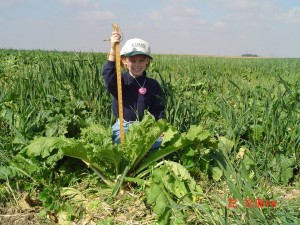
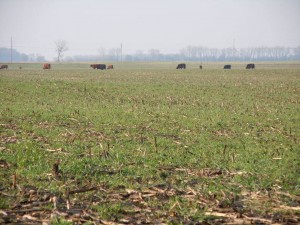
Cereal Rye and Cover Crop Radish
Nick Saathoff from Northern Illinois had excellent success in the fall and winter of 2012 grazing. Nick planted 1 bu/acre of Cereal Rye and I believe 5 # cover crop radishes. Nick grazed the cows up to Christmas in northern Illinois and had more rye to graze in the spring. While radishes are not grazed quite as well as turnips they still work well in this grazing situation.
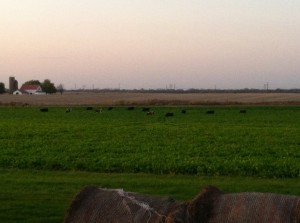

Oats and Austrian Winter Peas (or Forage Peas)
While this is not my favorite mixture, it is one that provides good quality feed, produces nitrogen, and is a very good cover crop. Why is it not my favorite? Cattle do not generally graze peas as well as they do other high quality forages (especially turnips). If growing conditions are good (not too hot and with good moisture), this mixture can crank out the yield!
I’d prefer that this mix is harvested but hey – grazing can sure work well for this too! Inoculate the peas and plant this mixture 1-2 inches deep to achieve the best stand.
Oats and Crimson Clover or Oats and Cereal Rye and Crimson Clover
These mixtures both can provide excellent grazing opportunities. Cattle will graze the crimson clover better than peas and very possibly will survive the winter in many regions for spring grazing (with or without the cereal rye). These mixes work well planted 1/2″deep – or plant the cereal grains 1-2″ deep and seed the crimson clover 1/4 to 1/2″ deep. For best fall grazing opportunities plant these in late July through mid-August in the Upper Midwest and into early September in the Corn Belt. Be sure to plant pre-inoculated crimson clover or inoculate the seed before planting.
Italian (or Annual) Ryegrass and Appin Turnips or Pasja Hybrid Brassica
This mixture can provide very good grazing opportunities where good moisture, moderate temperatures, and high fertility are present. This will be the highest forage quality of all of the mixes listed in this article. However, if it remains exceptionally hot and dry, this mixture will not be as productive as those previously mentioned. This mixture works best when strip grazed or rotationally grazed.
- Italian Ryegrass like Feast II or Annual Ryegrass can be very productive in high fertility situations. Add Pasja or Appin and the yield and quality are greatly improved.
